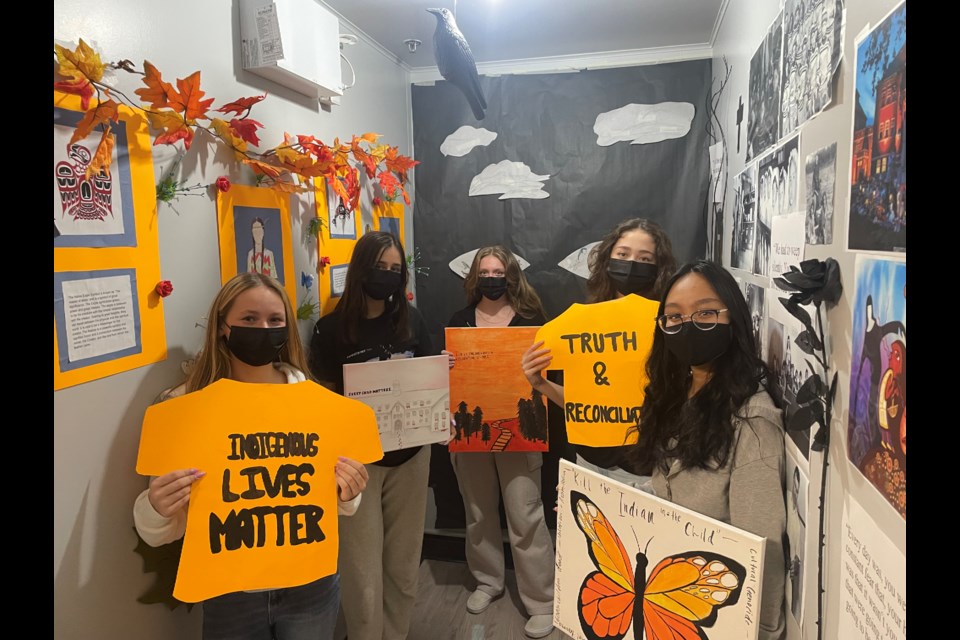A “museum” set up by students at Hugh Boyd secondary aims to raise awareness of the lasting impact of the residential school system on Indigenous people, juxtaposing life before and after that system was introduced.
It’s one of the ways that students and staff at Hugh Boyd will recognize the first annual National Day for Truth and Reconciliation, which falls on Sept. 30.
As schools won’t be in session Sept. 30, Richmond schools are recognizing the day on Sept. 29, according to Richmond School District.
Several schools are planning school-wide assemblies, school libraries are highlighting resources by Indigenous authors and teachers are “supporting the building of student knowledge and understanding” through various activities.
Michael Taylor, who teaches the social justice class at Hugh Boyd, said half of the museum display — researched and put together by students — will highlight Indigenous culture and ways of life prior to residential schools.
“And so everything’s going to be bright and colourful and open, and then the other half of the display is going to centre on the tragedy of the residential schools, the loss of identity for those who attended them, the survivors, as well as the lasting emotional toll,” he said. “So it’s really the juxtaposition between Indigenous society pre-colonialism, pre-residential schools, and then Indigenous culture during the residential school era and its impact today.”
Orange ribbons will also be provided to students and miniature orange shirts will be placed on one in every 25 lockers to symbolize that one in every 25 students who attended residential schools died. Meanwhile, student council members Mahara Remtula, Kento Weil, and Brett Lam will be providing a presentation highlighting the stories of residential school survivors.
Teachers will be taking their students from station to station to help them learn more about the impact of the schools. Students will also be making bannock, which they will sell to others in the school to help raise money for the Indian Residential School Survivor Society, which helps survivors.
In May, Tk’emlúps te Secwépemc First Nation announced the discovery of around 200 potential burial sites on the site of the former Kamloops Indian Residential School. Several other potential burial sites across the country have since been identified.
Shortly afterwards, the federal government passed legislation to recognize Sept. 30 as the National Day for Truth and Reconciliation, a statutory holiday to honour the lost children and survivors of Canada's residential school system.
Christian churches and the federal government launched the residential school system in the 1880s, and kept them going for more than a century, seeking to convert and assimilate Indigenous children.
It’s estimated 150,000 Indigenous children were taken from their homes across the country and forced into residential schools, where they suffered widespread physical, sexual and mental abuse. Thousands died in them.
Taylor said the news of the discovery at the Kamloops school made students’ awareness of residential schools and their legacy “much more tangible.”
He said students in the social justice class discuss how residential schools and colonialism connects with issues such as over-incarceration of Indigenous people, missing and murdered Indigenous women and over-representation of Indigenous people among the homeless population in Vancouver.
“So we bring it to the present day, and current events. We want to understand this intergenerational trauma.”
Sept. 30 coincides with Orange Shirt Day, which honours the story of Phyllis (Jack) Webstad, a former residential school student who had her new orange shirt, bought by her grandmother, taken away on her first day at residential school. The orange shirt has since become a symbol of remembrance of all Indigenous children removed from their families to attend residential schools.
While the social justice class has previously recognized Orange Shirt Day, Taylor said, they “really have the whole school, even more so, behind us this year,” including student council and staff members who “are wanting to pass along the messages of truth and reconciliation and having students understand what that means.”
He said the goal is for students to walk away with “a sense of what is truth, and what does reconciliation mean as it applies to the residential school system?”
Part of that understanding, Taylor said, is to have an accurate historical account of what happened, and to look at that information and stories of survivors with understanding and empathy.
At the end of the last school year, school librarian Jane Leung and teacher Greg Van Vugt engaged every student in the school in a “reflection” following the discovery of the burial sites, making commitments about what they thought they could do to better understand reconciliation, which they wrote on orange shirts. Those shirts are also part of the Sept. 29 activities.
“Students will come back to what they stated as a commitment… what they think they could do further, what are some specific acts of reconciliation.”
—With files from The Canadian Press and Maria Rantanen



